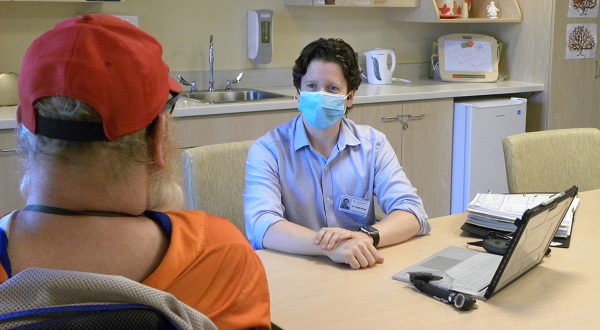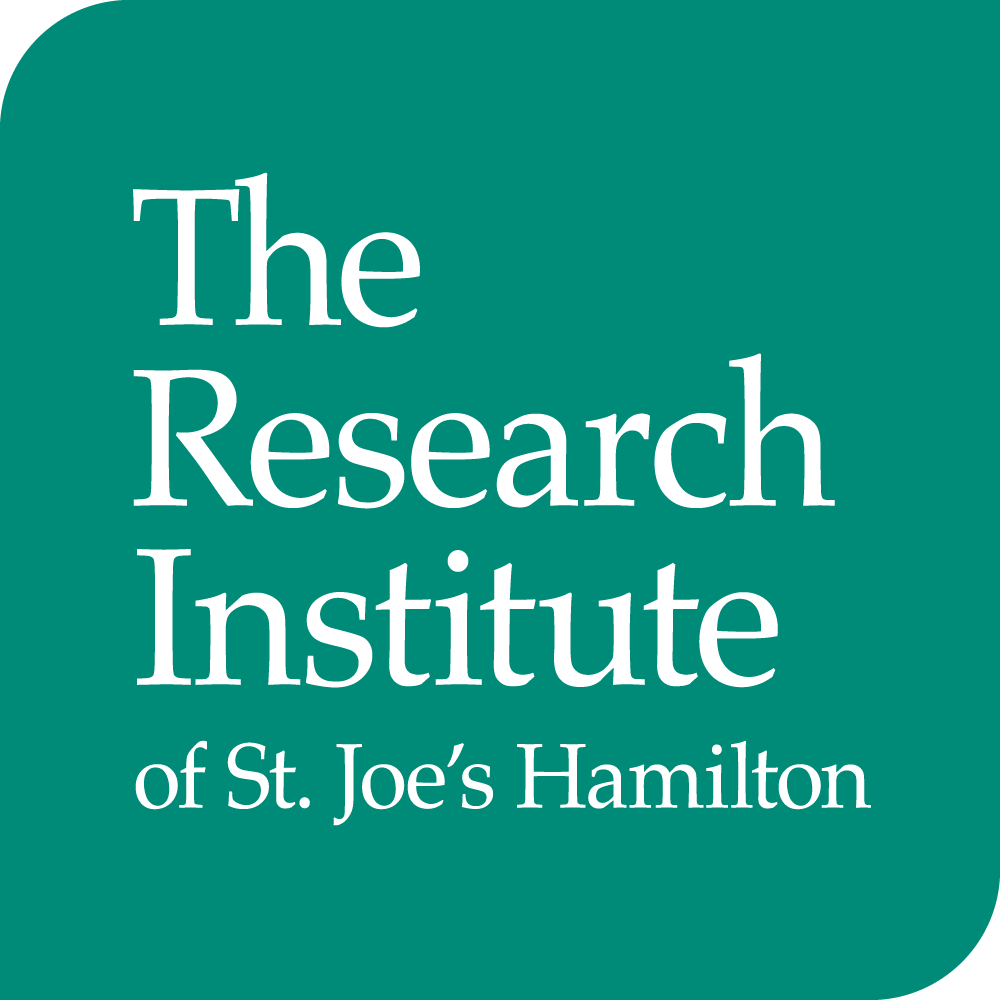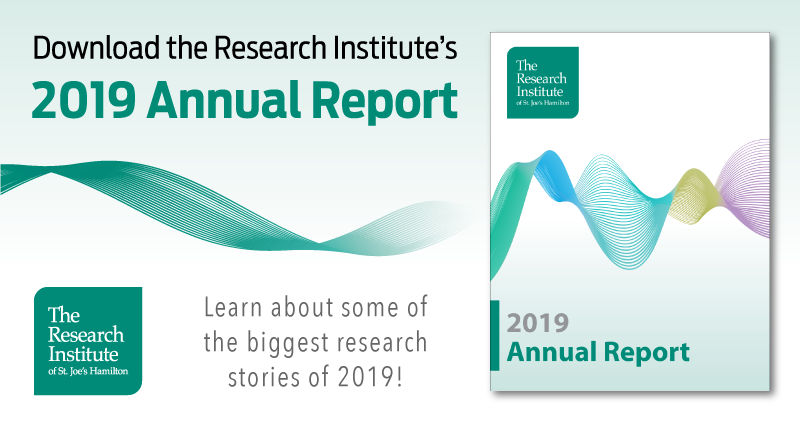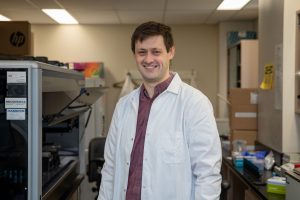The Research Institute of St. Joe’s Hamilton publishes an annual report to highlight how research at our hospital impacts the science of medicine and how it benefits the lives of patients in our community and around the world.
In our latest report reflecting on 2019, we examine exciting new international collaborations in neuroscience, drug advances in halting the progression of pulmonary fibrosis, St. Joe’s state-of-the-art Imaging Research Centre, novel basic science targeting hypertension and prostate cancer, and much more. The 2019 report also profiles St. Joe’s GUIDE Group, a team of physician-researchers who produce clinical practice guidelines based on the best evidence.
Download your copy of the 2019 Annual Report today!
The COVID-19 pandemic has highlighted the need for strong collaboration and clear communication among healthcare providers, particularly when it comes to vulnerable older adults. A unique partnership is creating a digital link between hospital and long-term care (LTC) homes to ensure clear, accurate information flows quickly and easily between the two healthcare providers when transferring patients, to reduce the potential for delays or errors in care. The intent is to improve health outcomes for older adults transferred between hospital and long-term care.
For hospital patients going to a LTC home, this means their hospital team will be able to send medical information to their LTC team – directly from the hospital system to the LTC home. The same will be true in reverse for residents of a LTC home going into hospital.
This fast, bi-directional exchange of medical information will bring many benefits, in terms of speed and accuracy of information, which is important now more than ever as we are faced with the challenges of a pandemic. COVID-19 has struck many residents of Ontario’s long-term care homes, prompting partnerships with hospitals to provide assistance and making the direct and rapid exchange of information between hospitals and LTC homes even more important to enable patient-centred care. While this initial project will focus on local Hamilton healthcare providers, the intent is to develop a successful digital tool to support hospital/LTC transitions across the province to improve the health outcomes of LTC residents. A large-scale improvement of this kind will be of interest to the recently announced independent commission into Ontario’s long-term care system.
St. Joseph’s Healthcare Hamilton (SJHH) and St. Joseph’s Villa in Dundas are the hospital/LTC partners involved in the project. Both partners already collaborate under St. Joseph’s Health System (SJHS), a leader in integrated care, creating this unique opportunity to test a cooperative pilot project.
The third partner is Canadian based PointClickCare, the leading cloud-based technology partner to North America’s LTC industry. PointClickCare is providing the solution, known as Harmony, to make this integration possible.
The project is funded in part by the CAN Health Network, as an innovative Canadian technology project developing solutions to address important challenges in our healthcare system. The CAN Health Network was created in July 2019, as a result of a Federal Government investment totaling $7 million, of which the Federal Economic Development Agency for Southern Ontario (FedDev Ontario) and Western Economic Diversification Canada (WD) each contributed $3.5 million. This investment established the Network in Ontario and the West, with expansion to the East, Quebec and the North to come.

Dr. Alistair Ingram, Chief of Medicine at St. Joseph’s Healthcare Hamilton, the hospital partner in the pilot project which aims to improve health outcomes for older adults transferred between hospital and long-term care.
Healthcare systems across Ontario often operate under different digital health record systems. For patients transferred between these healthcare institutions, the lack of standardization can result in paper-based transfer of information, written notes and potential delays in relaying and taking action on important medical information. Having an integrated care coordination platform can reduce the potential for medication errors, difficulties in obtaining an accurate diagnosis, delays in treatment and care, and readmissions to hospital.
The purpose of the pilot project is to connect various hospital health information systems with long-term care homes to support care coordination and delivery by enabling better information sharing. Following the pilot, the hope is to expand the solution to other healthcare providers across the province and Canada. Not only will the solution help with the transfer of COVID-19 patients from LTC to hospital, but it will also enable broader goals around integrated care and information sharing, which are fundamental to the success of the newly created Ontario Health Teams. Additionally, the solution could help reduce the number of unnecessary emergency transfers, as well as and the time that residents may be waiting for information and treatment.

Dr. Hugh Boyd, Medical Director at St. Joseph’s Villa, the LTC partner in the pilot project. Following the pilot, the hope is to expand the solution to other healthcare providers across the province and Canada.
A multi-disciplinary team from across SJHS will work with PointClickCare, which provides the cloud-based digital health information system used at St. Joseph’s Villa, to enable the secure two-way exchange of patient data with Dovetale (Epic), the hospital information system used at SJHH.
Once the benefits of the project are evaluated, the team hopes to expand the initiative to other LTC homes in Hamilton that use PointClickCare’s cloud-based platform, and then to many more long-term and acute care facilities across the country.
If the pilot is successful, additional hospitals and LTC homes in the CAN Health Network will be able to procure PointClickCare, strengthening healthcare and contributing to the growth of PointClickCare and additional job creation in Canada.
QUOTES
“The partnership created with the CAN Health Network, PointClickCare and St. Joseph’s Health System showcases Canadian talent in supporting our older adults in long-term care homes,” said Dr. Dante Morra, Chair of the CAN Health Network. “This initiative will help strengthen our healthcare system by addressing healthcare challenges like COVID-19 while helping Canadian innovators like PointClickCare scale faster across Canada.”
“This is one example of how we can improve communication between healthcare providers in our own community to make sure no one falls through the cracks,” says Dr. Alistair Ingram, Chief of Medicine at SJHH. “Having shared systems that talk to one another is a step towards the future of healthcare, where we see seamless connections between regional healthcare providers and easily accessible patient information wherever the patient is being cared for.”
“We know transitions between long-term care and hospitals can have the potential for medication errors and poor communication can hurt older adults,” says Dr. Hugh Boyd, Medical Director at St. Joseph’s Villa. “When transferring care many of us will try to send thorough information or call directly to receiving physicians, but this can sometimes result in over 100 pages being sent either electronically or via fax. This will eliminate clinicians wasting time sorting through fragmented data and allow more time to focus on caring for patients. This will save time and save lives.”
“St. Joseph’s Health System is pleased to partner with CAN Health Network and PointClickCare to enable ‘One Digital Health Record’ for our patient and residents,” says Fraser Edward, VP Partnerships at SJHS Centre for Integrated Care. “Clinicians need seamless and secure access to the right information, at the right time, within their Patient-centred Information Systems. Through this initiative we will be evaluating how PointClickCare Harmony solution can meet this important requirement and enable SJHS to better support older adults in long-term care and community settings.”
“To support person-centered care, blind handoffs of patient information are simply no longer viable,” says BJ Boyle, Vice-President and General Manager of Post-Acute Insights, PointClickCare. “Innovative providers like St. Joseph’s Health System understand that with the right technology, they can gather, interpret and act on timely insights to improve the patient journey across multiple care settings.”
“Thanks to the support of the CAN Health Network, this great example of homegrown innovation will be able to help even more Canadians,” says the Honourable Mélanie Joly, Minister of Economic Development and Official Languages and Minister responsible for the Federal Economic Development Agency for Southern Ontario.
“Canadians are innovative and entrepreneurial. Through the CAN Health Network, our government is helping entrepreneurs access networks of support and customers in Canada – turning more innovative ideas into Made-in-Canada success stories, like PointClickCare,” says the Honourable Mary Ng, Minister of Small Business, Export Promotion and International Trade.
In 1890, our founders, the Sisters of St. Joseph of Hamilton opened a 25-bed general hospital. Over the last 130 years, we’ve established our reputation as a leading academic, multi-site hospital. In June 2020, we are celebrating 130 years of caring for our community and beyond.
Our pioneering spirit at St. Joseph’s Healthcare Hamilton began in 1852 when the Sisters of St. Joseph of Hamilton arrived to care for those most in need, a commitment that only intensified with the outbreak of cholera. Compassionate care for all is the Sisters’ legacy when they opened the doors of our hospital 130 years ago. This legacy continues to be infused in the foundation of the work we do each day at St. Joe’s, especially as we face the current COVID-19 pandemic together.
Over the last 130 years, each one of our employees, physicians, learners and volunteers have been committed to excellence and dedicated to discovery. In honour of all you have built together and all of the lives you have touched, we’re sharing some St. Joe’s ‘Then and Now’ photo moments.
Click and drag the bar in the centre of the photos to reveal the ‘Then & Now’ photos.
Pictured Above
Left photo: Sr. Euphrasia (left) and Sr. Angela (right)
Right photo: David Czaplinski, Registered Nurse, Waterfall 1 (left) with a laptop on wheels and Basma Ghwila, Patient Clerk Unit Clerk, Waterfall 1 (right) using a smart screen as a computer monitor
Pictured Above:
Top Photo: Sr. Jane (right) with patient in dialysis in the 80’s.
Bottom Photo: Randy Orlicki, Registered Nurse in our dialysis unit.
Pictured Above
Left photo: Sr. Mary Austin Reding in the busy nursery. Sr. Mary served in Maternity at St. Joe’s from 1957 – 1961.
Right photo: Justine Brown, Registered Nurse, Special Care Nursery.
Pictured above
Top photo: Sr. Teresita McInally, General Superior, 1990.
Bottom photo: Jennifer Olarte-Godoy, Nurse Educator, Mood Disorders, F1 and Nursing Resource Team
Thank you for 130 years of Leading, Learning, Building and Caring.
Thursday, 4 June, 2020
The Board of Directors of St. Joseph’s Lifecare Foundation and St. Joseph’s Lifecare Centre Brantford are pleased to announce the appointment of Julie Powell as President and CEO of St. Joseph’s Lifecare Foundation, effective June 8, 2020.
“I am extremely pleased and excited to welcome Julie to our Brantford campus,” says David Wormald, President of St. Joseph’s Lifecare Centre Brantford and St. Joseph’s Health Centre Guelph.
“Julie has an impressive track record of performance excellence and I know she will make significant contributions towards realizing the strategic goals of both the Hospice and Lifecare Centre.”
Julie brings to the position over 23 years of non-profit and fundraising leadership. She has worked within the St. Joseph’s Health System for the past three years as Director of Leadership Giving for St. Mary’s General Hospital Foundation, Kitchener, with a focus on leading major gifts, planned giving and sponsorship programs for the organization.
Prior to her role at St. Mary’s, Julie was Director of Development at Norfolk General Hospital Foundation in Simcoe, where she led the Foundation team to raise $1.5 million annually for new equipment needs at the hospital. Concurrent with the annual giving campaign and in partnership with volunteers, Julie spearheaded a $13 million capital campaign to renovate the hospital.
Previously Julie was the Area Manager for the Heart & Stroke Foundation, supporting offices in Brantford, Hamilton, Brampton, Kitchener, Guelph and Niagara in fundraising, health promotion and advocacy.
Julie has been a Rotarian for seven years and locally has volunteered with the Heart & Stroke Foundation for nine years. She has lived in Brantford for 20 years and is very passionate about working in and contributing to the community she calls home.
Incoming chair Steve Portelli stated, “The Board conducted a detailed, comprehensive search and of approximately 60 applicants, at least 10 were strong, viable candidates. Of those, Julie soon emerged as the ideal candidate for the position, meeting the benchmarks the Board had established for each level of the interview process. It was clear she was the right fit for us.”
Julie assumes the role on June 8, replacing outgoing President and CEO Olga Consorti, who is retiring in her 30th year with St. Joseph’s Lifecare Foundation.
“The Board is tremendously pleased and thankful to have benefitted from Olga’s outstanding fundraising skills, and especially for her vital role in the building of the initial Stedman Hospice in 2004 and the new Hospice, Hankinson House, in 2014. Olga also played an instrumental role in the redevelopment of the former St Joseph’s Hospital to create St. Joseph’s Lifecare Centre,” says Karen Robb, current Chair of the Foundation.
“We wish Olga the very best in her future endeavours,” says Robb.
Unfortunately, due to the COVID 19 pandemic, a planned retirement event for Olga Consorti has been postponed and an event to welcome Julie Powell will take place once face-to-face group meeting restrictions are lifted.
St. Joseph’s Lifecare Foundation is the official fundraising organization for both Stedman Community Hospice, a 10-bed hospice and community outreach centre, and St. Joseph’s Lifecare Centre, a 205-bed long term care facility, which together form St. Joseph’s campus of care in Brantford, part of the St. Joseph’s Health System.
HAMILTON, ON (May 21, 2020) – Scientists at The Research Institute of St. Joe’s Hamilton have developed entirely novel COVID-19 testing methods, which will allow for a significant increase in testing capacity across the province.
The new methods are being implemented in the Hamilton Regional Laboratory Medicine Program (HRLMP) – a partnership between St. Joseph’s Healthcare Hamilton and Hamilton Health Sciences – which is responsible for conducting clinical COVID-19 testing for the region. Currently, the HRLMP clinical testing capacity is 800 samples per day. With these advancements in place, scientists are aiming to test up to 6,000 samples daily.
Dr. David Bulir and Dr. Marek Smieja, infectious disease physician-researchers from St. Joe’s Disease Diagnostics and Development (D3) Group, predicted the need for an alternative supply of testing materials in January.
“In the face of global shortages, we’ve had to secure a new supply of all the materials required for COVID-19 testing, as well as invent some components that enable mass testing,” said Dr. Gail Martin, Executive Director of The Research Institute of St. Joe’s Hamilton. “St. Joe’s has effectively rebuilt and secured an entire supply chain, one that is urgently needed to manage the shortage of testing supplies.”
While some materials have been sourced and validated from new suppliers, such as flocked swabs and specimen tubes, other materials, including the new transport medium, are entirely novel. Dr. David Bulir developed the new transport medium and an enhanced test for COVID-19 at St. Joe’s research laboratory.
One of the key benefits of using these new testing materials with Dr. Bulir’s newly developed COVID-19 test is the ability to pool specimens. Specimen pooling can enable labs to increase their testing capacity up to fourfold, and potentially more. Since most tests produce negative results, only pools that come back with positive results will need to be further examined.
Building up the province’s stockpile of testing supplies and its capacity to perform rapid testing are vital as municipalities gradually lift lockdown restrictions.
“We’re working with the province to ensure we can rapidly develop ways to provide these new materials to other labs,” said Dr. Martin. “This is a Made-in-Ontario solution to a critical global shortage.”
This project will have a significant impact on the increased testing that will be needed to emerge from COVID-19, the value of which has been demonstrated through the Surveillance Pilot Project, launched in collaboration with St. Joseph’s Health System. That project aimed to detect the spread of COVID-19 and determine the most effective testing strategies in long-term care and congregate settings.
Development of these innovative testing methods could not have been possible without the support and funding from the Juravinski Research Institute, the Ontario COVID-19 Rapid Research Fund, St. Joseph’s Health System, and The Research Institute of St. Joe’s Hamilton.
Premier Doug Ford announced the Ontario COVID-19 Rapid Research Fund projects at a press conference Thursday afternoon, expressing his enthusiasm for the St. Joe’s project.
Background Info:
Shortage of testing supplies
- Due to factory closures in Italy where the gold-standard flocked swabs and transport media are produced, as well as stockpiles that were not maintained at pandemic-level quantities by manufacturers, standard testing supplies are scarce.
- St. Joe’s researchers designed a new supply chain to address this issue across Ontario
Specimen pooling
- Instead of running each specimen through its own test, specimens can be combined into a single test to increase throughput.
- Since most tests are expected to have negative results, pooling allows for massive increases in concurrent testing. Specimens pools that come back positive can be further tested individually.
- Pooling will allow many more tests to be performed in the same timeframe
Deployment of robotic liquid handling technology
- Using robotics in the laboratory reduces risk to lab technicians, while increasing the speed and the number of concurrent tests that can be run
New transport medium
- A transport medium is the liquid in the specimen tube that maintains the integrity of the sample while it is transported to the lab.
- Unlike many transport media that keep the virus intact before testing, St. Joe’s new transport medium breaks down the virus, effectively killing it.
- The new transport medium works well with Dr. Bulir’s robust COVID-19 test. This new medium reduces biological risk to the scientists conducting the tests and enables increased testing capacity.
Published: Thu., May 14, 2020
Forty-one days, at least six tests and two negative results.
That’s what it took for Helen Keene to see the light of day beyond the COVID-19 unit of St. Joseph’s Hospital.
On Wednesday, she was finally discharged to fanfare.
Lining the hall, nurses, doctors, cleaners and other hospital staff clapped as registered nurse Tanirose Guiao pushed the 71-year-old’s wheelchair out the doors.
“My heart exploded,” said Keene. “I was so overwhelmed with the kindness and generosity. That was a gift.”
Keene was admitted to hospital in early April when she became one of the first residents infected with the respiratory virus at Cardinal Retirement Residence.
The Herkimer Street institution has been home to one of the worst outbreaks of the virus in Hamilton. There were 65 cases — 47 residents and 18 staff — before the outbreak was declared over May 3.
When Keene first came down with the virus, she was having trouble breathing, she had a fever and her white blood cell count had dipped.
Due to her medical history, which includes open heart surgery and stent, Keene was put on a heart monitor. She also developed a “horrendous” cough.
“It was so bad my rib cage was bruised and sore,” she said. “I couldn’t even touch my chest, I was in so much pain. It hurt to breathe.”
But, Keene still counts her lucky stars that she never ended up on a ventilator — a story she became far too familiar with hearing in the hospital.
“I was one of the blessed ones,” she said. “I was thankful for that every day.”
Having been under close watch by staff, Keene said she now considers those who cared for her to be her “extended family.” Guiao, a 23-year-old nurse from Burlington, was with her through the entire journey.
The pair got to know one another between waves at the windows and chats while Guiao was checking in on her. Guiao knew Keene was grieving the loss of her husband, Michael, who died two years ago and that the song “I’ll See You Again” by Westlife kept her grounded.
Last week, following a negative result, Keene tested positive again. Lying in bed, feeling depressed and missing Michael, Keene suddenly heard the tune over the intercom, dedicated to her by the team.
“It made the … stay possible to tolerate,” she said. “It was unbelievable what they did for me.”
But on Wednesday, that news shifted.
Guiao was able to deliver Keene the results she had been waiting for — she had tested negative for the second time in 24 hours and she was going home.
“We were screaming and yelling and we high-fived each other,” said Guiao. “It was such a joy.”
Even if it had been positive once again, Keene’s resilience in the hospital was “inspiring,” she added.
“(Helen) never gave up and she always had a positive attitude,” said Guiao. “It was a pleasure caring for her … she’s a fighter.”
Having “conquered” the virus, Keene is hopeful that people will continue to follow physical-distancing measures, live day by day and avoid feeling resentful for the time they may miss with their loved ones.
In her own condition, Keene realizes she could have been one of the “unlucky ones.” As of Thursday, the virus had claimed the lives of 25 people in Hamilton.
“You don’t know what to expect, and no one can tell you what to expect,” she said. “It comes back down to who you are and what you have to offer.”
Fallon Hewitt is a Hamilton-based reporter at The Spectator. Reach her via email: fhewitt@thespec.com



